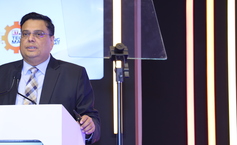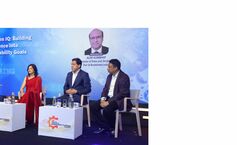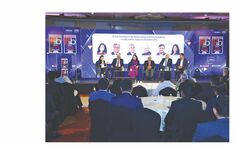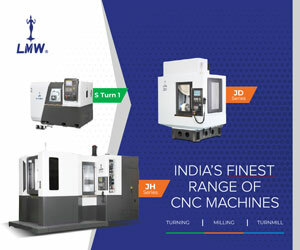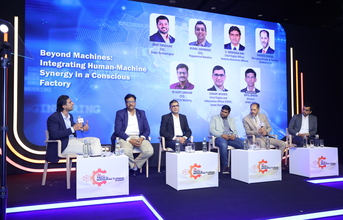
Beyond Machines Panel
In a world increasingly captivated by the potential of Industry 4.0, the discussion is evolving from simple automation for efficiency to intelligent collaboration between human insights and machine intelligence. Central to this shift is the concept of the conscious factory production ecosystem that doesn't just mechanise but harmonises, where human decisions are enhanced, not replaced, by machines.
Recently, a high-level industry panel moderated by Vipul Bhatia, Director, KPMG India at the ET Now Machinist Tech in Manufacturing, brought together several industrial leaders to explore this intersection of cognition, emotion, and computation.
The ROI of Automation: Myth vs. Reality
For Runal Dahiwade, CEO of Peppermint Robotics, the question of ROI is not just routine, it's fundamental. "We often assume that India has a surplus of unskilled labour, and thus automation has little value here," he observed. "But the truth is exactly the opposite, especially in urban India."
Dahiwade debunked the myth that automation is a luxury in low-wage economies. "Gig economy jobs have changed aspirations. Today, even those who might earlier take up mundane cleaning jobs would rather deliver food or work in logistics," he
noted. "And with attrition, inconsistency, and the cost of relievers across multiple shifts, the ROI on robots often lands within the first year, sometimes within eight months."
Automation, for Dahiwade, is no longer about replacing labour, but filling a widening gap in supply and quality.
Surveillance, Privacy & Ethics in Machine Learning
In the security technology domain, Sanjeev Sehgal, Managing Director & Founder of SPARSH CCTV, painted a picture of surveillance evolving from luxury to necessity. "Twenty-three years ago, even airports had no cameras. Now, it's unimaginable for a home to be without one."
Yet, the deeper issue lies in privacy. "We are entering a phase where privacy legislation is catching up. Surveillance systems must evolve to protect individual rights while offering public safety," he explained. Sehgal cited innovations in 3D perception and facial recognition accuracy modelling. "The system doesn't need to record every passer-by; it can focus on anomalies or threats."
He emphasised SPARSH's role in shaping regulations, sharing, "I'm the convener for the BIS Committee on video services. The government is now actively engaging with manufacturers to craft frameworks that ensure ethical data use and cybersecurity compliance."
Human Oversight in High-Stakes Environments
Mining, with its hazardous conditions and complex compliance structures, offers a unique lens on digitalisation. S. Srinivasa Rao, Chief Digital Officer at Vedanta Aluminium (Mines), explained that while digitisation has taken off, particularly with the support of startups through Vedanta Spark, humans still hold the final decision-making authority.
"We use AI to provide insights, but not conclusions. In mining, decisions can have high risks. If a machine suggests stopping an operation due to 60 per cent deterioration, we must still consider the context—operational risk, resource constraints, and economic impact," he said. "Until AI can understand such dynamic contexts, human judgement remains critical."
Interoperability in a Fragmented Tech Landscape
Interoperability emerged as a recurring pain point. Sanjay Mishra, Chief Digital and Information Officer at Jindal Stainless, acknowledged the challenge. "Legacy systems, point solutions, and Excel sheets—they all create silos. So, we are adopting a hybrid approach," he stated.
Jindal Stainless has embraced a ‘sensor-to-cloud' model: "Wherever possible, we collect machine data via edge computing, process it locally, and send only the relevant data to the cloud. This ensures scalability, avoids latency, and makes future upgrades smoother."
He added, "We are not just designing for today. We are designing for a future where low latency, continuous improvement, and adaptability are paramount. That's why strategic planning involves business heads, engineers, and IT leaders alike."
Data-Driven Design Thinking
In the automotive space, M Gopi Sankar, CTO at SWITCH Mobility, illustrated how machine data is not only supplementing design, but leading it.
"We used to treat the product like our baby. Now, we treat it like our boss," he quipped. "When we launched India's first double-decker EV, real-world data showed average speeds were just 12–15 km/h, not 40 km/h as assumed. That changed how we designed the drivetrain and battery systems."
Gopi highlighted the role of generative design—a machine-led process of creating optimised engineering solutions based on diverse inputs. "Today, the design comes from customers, machines, simulations, and field feedback. The engineer becomes a curator, not the sole creator."
On whether machines can eventually comprehend human emotion, Gopi was optimistic. "We already see AI reading facial cues, adjusting vehicle settings, even detecting intoxication. Electric vehicles enable tighter integration between driver mood and machine response. The emotional connection between humans and machines is growing, whether we call it empathy or intelligent reaction."
Co-Creating the Future
What emerged from this wide-ranging dialogue was a nuanced portrait of factories not as cold, clinical hubs of production, but as living ecosystems of continuous interaction between machine precision and human discretion.
As moderator Vipul Bhatia summarised, "This isn't about replacing humans or surrendering to machines. It's about a partnership—where data enables decisions, automation fills labour gaps, and AI augments creativity."
In the conscious factory, machines may learn, optimise, and suggest. But the heartbeat of industry still lies in the human ability to empathise, contextualise, and decide.
And in that delicate dance—between logic and emotion, between insight and instinct, the future of smart manufacturing will unfold.







